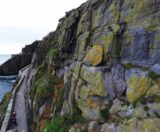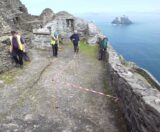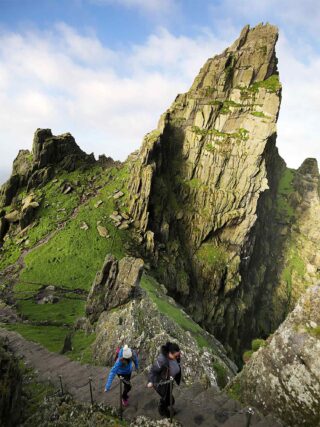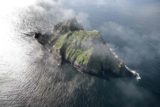
For some employees of the OPW Heritage Service however, the journey to work – and what they do when they get there – is highly unusual to say the least. Take the men from the OPW’s Killarney National Monuments District who, early every Monday morning for several months each year starting in about mid-April, embark at the landing stage next to the Skellig Experience Centre in Portmagee, Co. Kerry and make the 90 minute trip across 12 kilometres of ocean to the rocky island of Skellig Michael. These are the men from the OPW’s National Monuments District who maintain the fabric on this most exposed and haunting ancient Hermitage and World Heritage Site; in the words of some locals, they are “the lads who mind the Rock…”
Tom Kerrisk, John Lyme, Michael O’ Connor, James O’Donoghue and Foreman Pat O’ Shea have between them probably worked for more than 100 man years on Ireland’s National Monuments in State care in the Kerry District. Their collected experience is huge and their knowledge of the Monuments they look after is extensive. Their District Manager, Maurice Fitzgerald, is also steeped in the tradition of the work, having been himself involved for many years working on the same portfolio of properties and possessing a deep understanding of them and their individual challenges.
...in the words of some locals, they are “the lads who mind the Rock

For some of the year, the teams’ work involves them in traveling to many of the historic sites scattered on the long southern Kerry peninsulas of Iveragh and Dingle and, compared to the journey to Skellig Michael, getting to places like Loher Stone Fort or Ballinskelligs Abbey is a relatively easy task. Their work in these places involves maintaining the structures of these places, checking for displaced masonry, looking for any unusual movement in the stone or any damage from animals or people perhaps that needs to be corrected before it results in lasting effects. Other tasks will include repairing fencing or boundary walling, cutting grass sward during the season and keeping a vigilant eye for any developing hazards like wayward stones or uneven footpaths that might trip an unwary visitor.
The work they do at Skellig Michael is however markedly different and that’s not just down to the unusual – and frequently rather damp – commute. When they get to work on Skellig on Monday morning, it’s the first day of a five day stretch for them. Due to the distance from the mainland and the highly variable nature of the weather and sea conditions, they will stay on the island for the entire week, returning to Portmagee and weekend pursuits of home and families only late on Friday evening. During the week, they have the company of visitors during the day – assuming the weather conditions have been good and landings are feasible – but shortly after midafternoon, they only have each other and the three OPW guides resident on the island during the summer for company or perhaps one of their occasional colleagues visiting temporarily from Killarney. And, oh yes, several thousand Fulmars, Manx Shearwaters, Puffins, Guillemots, Storm Petrels, Kittiwakes and Gannets…
Working on National Monument stone structures is a challenging task at the best of times. Remaining faithful to traditional skills means using lime mortar for example; a material that can take days to dry out fully and has to be protected from the elements throughout. Not exactly easy in a rainy Irish climate. These basic difficulties are all magnified however when it comes to Skellig. There is no natural fresh water source on Skellig Michael and every drop of water, every scrap of building material, all scaffolding and other supplies used has to be transported to the site by boat or helicopter before work can begin – a mix of logistical and weather prediction juggling and problem solving Maurice Fitzgerald as District Works Manager, Killarney has to tackle every year.

The very physical nature of the site itself presents unusual challenges too. When working at the Monastery on the summit, the men have to physically haul all their tools, mortars and building material up the more than 600 ancient steps to the top before they can even start to repair a piece of dislodged stone or attempt to reshape a crumbling wall top. The separate Hermitage structure on the even more precipitous South peak was also conserved by the team in recent years and the challenge involved in working on what is essentially a fragile building perched on a rock outcrop 217m high can only be wondered at. Lower down, nearer sea level, much work in recent years has focused on the reconstruction and repointing of the Lighthouse Road wall – a seaward facing stone barrier built largely by the Lighthouse keepers in the 18th century along the access road that leads from the landing pier right up past the base of the monastery steps and onward to the Commissioners of Irish Lights Lighthouse at the southerly tip of the Island. As the team have worked on this wall in recent years, they have moved slowly along its length, operating from impossible-seeming scaffolding perched outside the wall itself on the cliff face. Safety harnesses, ropes, and climbing gear are the order of the day, all organised by the Safety Contractor, Mike O’ Shea who is, at this stage, practically part of the wider OPW family on Skellig, having himself spent about 10 years on the site.
There is, of course, a very public dimension to Skellig Michael. Every year, thousands of visitors manage to make their way to this UNESCO World Heritage Site (although many fail to succeed because of the weather and sea) and it is the job of the OPW team to prepare the site for their arrival and try and make sure that conditions for their visit are maintained as safe as possible. Skellig can be a dangerous environment and there have been some fatalities among visitors over the years. Before the start of each visitor season therefore, the team access the site early during the month of April – weather permitting – and begin their tasks of preparing the island for visitors. This means thoroughly cleaning winter storm debris from visitor areas, removing algae from the pier, checking each of the steps up to the Monastery to make sure they have not been dislodged or loosened by the effects of weather or nesting birds and ensuring that there is no rockfall material preparing to shed from slopes above the road. Access to the island in this early part of the year can be highly challenging however and regular landings can sometimes prove impossible until relatively late in the month of April. Even when they can land however, the sea can still play its tricks and, as has happened more than occasionally, the men have been stranded for almost 10-day periods when the weather has turned and they could not be taken off on the scheduled Friday. Getting stranded on a remote Island may seem like a romantic idea, but the reality of rainy days and dwindling food supplies is a little different and as Eoin Walsh, OPW’s local Boatman who manages the transport arrangements, said after the most recent delay: “they were a bit thinner when I got them home.”

Even though the very act of simply going to work on Skellig Michael presents real hardships – something that most of us would never dream of in our own daily commute to work – it is clear that there is a significant challenge for these men and their colleagues in Killarney in doing what they do and an inherent respect among them for the island and what it represents. Their commitment to the work and to making sure that Skellig Michael stays the gem that it is speaks volumes for the amount of continuing and persistent effort that is needed to keep not alone this site but all of Ireland’s Heritage estate in the care of the OPW in good shape. “Minding the Rock” it would appear, will be a job that will be around for quite a while.
Frank Shalvey works in the OPW Heritage Services managing portfolio and visitor issues related to the National Monuments estate.


